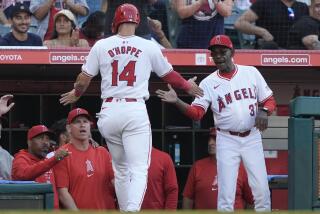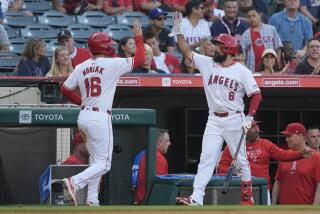Strong Arms Take Center Stage
- Share via
TEMPE, Ariz. — An Angel organization that has failed to produce enough quality pitching to win a division title in 15 years may have a pleasant problem by 2003 or 2004: A surplus of excellent arms.
Nine of the team’s top 15 prospects, according to Baseball America, are pitchers, and three of the top six rotation candidates for this season--Ramon Ortiz, Jarrod Washburn and Scott Schoeneweis--are 27 or younger.
But will the Angels have a lineup that can compete for the American League West championship by then? Two key offensive players, Darin Erstad and Troy Glaus, will be in their prime in 2004, but Mo Vaughn and Tim Salmon will be 35, and Garret Anderson will be 32.
A system that has churned out highly productive big leaguers such as Salmon, Erstad, Anderson, Glaus, Gary DiSarcina and Jim Edmonds in the past decade has a scant supply of high-end position-playing prospects.
Timing never has been an Angel strength. The organization has a history of obtaining stars past their prime or trading them before their prime, and has been unable to mix a potent offense with good pitching in recent years.
Wouldn’t it be just like the Angels to finally have an excellent rotation in a few years but not have the hitters to support it?
“You have to look at the thing and say, how big is the gap?” Angel General Manager Bill Stoneman said of the possibility of the offense aging before the young pitchers mature. “The perception of the gap might be bigger than it actually is.”
That gap could close quickly, depending on how fast young pitchers such as Joe Torres (18) and Chris Bootcheck (22)--both first-round picks in the 2000 draft--Francisco Rodriguez (19), John Lackey (21) and Phil Wilson (20) reach the big leagues.
At the same time, the Angels do not want to rush them. That’s why veterans such as Ismael Valdes and Pat Rapp are in camp this spring, to give the young arms more time to develop.
If there is a gap, the Angels might be forced to trade some of their pitchers for position players in the future, but that’s a luxury Stoneman won’t mind.
“That would be awesome,” said Stoneman, who traded one young pitcher, Seth Etherton, away this winter. “What can be better than to be really strong pitching-wise?
“If you’re so deep that you have pitchers other people covet and you can move a guy, the value you get in return can be significant. But the real value is to yourself.”
You can see the eyes of Stoneman; Darrell Miller, the team’s director of player development; and Donny Rowland, the team’s scouting director; light up as they talk about the team’s pitching prospects and the rest of its farm system.
Since Stoneman replaced Bill Bavasi on Nov. 1, 1999, he has made it clear his top priority is to beef up a farm system that Baseball America ranked 30th out of 30 teams in 1999 and 29th in 2000. So it’s in his best interest to promote prospects.
But is the Angel farm system really that much better now than it was a few years ago? An evaluation of the team’s prospects shows considerable progress, but there still is a long way to go.
In Baseball America’s newest organizational ratings, to be issued in March, the Angels moved up to 25th, ahead of the Indians, Orioles, Dodgers, Diamondbacks and Brewers.
The quality and depth of their pitching has improved significantly, but they’re thin on position-playing prospects, especially power hitters. They’ve also upgraded their Latin American program, and that could pay dividends in the next few years.
“They had a good draft in 1999 and a better draft in 2000, but there’s a big caution because most of their top guys haven’t played a full season yet,” said Jim Callis, who for about 10 years has written for Baseball America, the sport’s foremost authority on player development.
“It’s easy to get excited about all the new guys, but maybe it’s not so much that these guys are so good, but the guys they had in their system before stunk. I think it’s a combination of things.”
Bavasi and Bob Fontaine, the former player development director, had a history of success with top draft picks such as Erstad and Glaus, but had a more conservative philosophy when it came to pitching.
They usually opted for polished college pitchers such as Brian Anderson, Brian Cooper and Etherton, who were closer to reaching the big leagues but didn’t have the raw potential and power of other prospects. Since 1985, the Angels have selected 20 pitchers in the first round. Only two, Anderson and Chuck Finley, are in big-league rotations today.
Bavasi and Fontaine veered from that approach in 1999, using their first seven picks on power pitchers, and Stoneman, Rowland and Miller have carried that a step further, opting for higher-ceiling, higher-risk players at every position, stressing athleticism over polish.
“You’re going to miss on some guys, but some of the guys you hit on are going to be superstar-type players,” Miller said. “That’s the biggest difference.”
That approach has yielded Torres, Rodriguez, Lackey, Bootcheck and Wilson, who are considered the Angels’ top five pitching prospects. All are power pitchers with outstanding fastballs, and all except Rodriguez have big bodies who scouts believe will project well in the big leagues.
“We’ve picked up some size and some filth,” Miller said. “These guys have pretty nasty stuff and good makeup. They’re hard workers.”
The other top pitching prospects are Derrick Turnbow, who spent 2000 in the Angel bullpen but likely will start at double A this season, Matt Wise, a 24-year-old right-hander who will compete for a rotation spot this spring, and Elvin Nina, a 25-year-old right-hander in big league camp.
And the Angels still have Ortiz, Washburn and Schoeneweis, young pitchers who are leading rotation candidates this season, and Cooper, Steve Green, Scot Shields and Mark Harriger in big league camp.
“The competition is going to be stiff, and that makes you better,” Lackey said. “It should bring everyone’s level up a bit, and that will help the whole organization.”
If there is a future logjam in the rotation, some pitchers will be moved to the bullpen. Some could be traded. Some will get edged out.
“In a couple of years, we’re going to release some . . . good players,” Miller said. “It’s a shame, but it’s a good problem to have.”
Miller may not be able to say the same about the crop of position-playing prospects.
The Angels have a speedy outfielder in Nathan Haynes, a 21-year-old who some believe can be a Kenny Lofton-type leadoff hitter, two promising shortstops in Wilmy Caceres, a 22-year-old who will compete for a big league job this spring, and Brian Specht, a 19-year-old switch-hitter, and a highly regarded power-hitting catching prospect in 19-year-old Jared Abruzzo.
There is little in the way of third basemen, which may not be a problem as long as the Angels lock up Glaus, 24, to a long-term deal soon, and first basemen, where the prospect list thins after Larry Barnes, a strong defensive player who is competing for the Angel job this spring.
The best middle infield prospects, including Specht and slick-fielding 22-year-old second baseman Alfredo Amezaga, who is in major league camp, are several years away from the big leagues.
Two outfielders, speedy Elpidio Guzman, 22, and power-hitting Gary Johnson, 25, could be big-league ready by the end of this season, but neither is close to being good enough to displace Anderson, Erstad and Salmon in the current Angel outfield.
“After Haynes, it’s pretty bleak as far as position players,” said one front-office executive familiar with the Angel organization. “They have some work to do to replenish the system.”
They seem to be headed in the right direction.
“Rome wasn’t built in a day, and we’re not building this in a day,” Miller said. “We’re turning this in a positive direction. Obviously we’re not there yet, but it’s hard to do in one year.”
More to Read
Go beyond the scoreboard
Get the latest on L.A.'s teams in the daily Sports Report newsletter.
You may occasionally receive promotional content from the Los Angeles Times.







